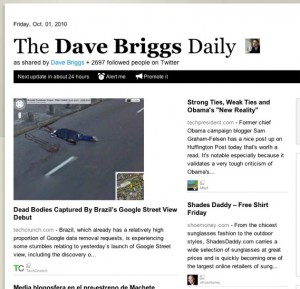The point, of course, is that if the central thinking is that communications are about crowd control, then organisations are really forcing the many-to-many communication outside their organisation. Although I don’t think we are about crowd control at the department, the fact that we don’t have our new communications channels yet has already resulted in crowds forming beyond the firewall. Imagine the circumstance when new channels, far being lacking, aren’t even allowed.
My conclusion, based on this, is that crowd control is pretty much dead. And that centralised command-and-control will soon follow.
Public Sector Online 2010

Tomorrow (that’s Monday, 4th October) I’ll be at The Guardian‘s Public Sector Online conference, which looks like it should be a great day.
I’m on at 15:30, for the closing panel titled “Innovation in social media”. Here’s the skinny:
As more people use social networking sites to keep informed, and organisations use them to spread information and market services, what are the best ways for public sector bodies to engage with the public?
- The rise in the use of social networks as a line of communication
- Twittiquette – best use of Tweets
- Twitter as a public service: e.g. Gritterfeeds
- Generating and monitoring content – Social media etiquette
- Online engagement – encouraging two way usage
Joining me on the panel will be:
- Andy Gibson, co-founder, School of Everything and author, Local by Social
- Sarah Drummond, founder, mypolice.org
- Lauren Currie, director, mypolice.org
- Gordon Scobbie, assistant chief constable, West Midlands Police
Which means that, even if nobody else has any fun, at least I’ll get to hang out with some cool people for an hour or so!
If you are attending, do get in touch and let’s meet up! Twitter will probably be the easiest way.
Scheming Virtuously: A Handbook for Public Servants
I love stuff like this.
 Nick Charney works in government in Canada, and is also a prolific and excellent blogger. He’s also pretty active on GovLoop, which is where I first came across him I think. Anyway, follow his stuff.
Nick Charney works in government in Canada, and is also a prolific and excellent blogger. He’s also pretty active on GovLoop, which is where I first came across him I think. Anyway, follow his stuff.
Nick has just published an ebook called Scheming Virtuously: A Handbook for Public Servants which is great reading.
It’s “a tactical guide for any public servant looking to make an impact. It offers practical advice on how to be innovative in the public service while managing your relationships and reputation.” Awesome!
I have embedded the document below, or for those whose employers don’t trust them, here’s the direct PDF download.
I mentioned to Nick that the style reminded me a little of Colin McKay’s wonderful (even after 3 years!) Secret Guide to Social Media in Large Organizations – and it turns out that document helped inspire Nick to write his guide. Good stuff.
101 cool tools: Paper.li
This is a new regular series of posts where I highlight a cool online service that you may or may not have heard of. Whether I ever make it to 101 is debatable I feel… I’ve also set up a Twitter feed where links to these posts will be automatically pumped.
This is the first post, and it’s about paper.li.

Paper.li is a service that integrates with Twitter, and creates a dynamically produced page, that looks a bit like a newspaper, from the links that are added to Twitter.
You can create a paper from your own (or indeed, someone else’s) followers, or a hashtag, or one of your lists of Twitter users. Here’s what mine looked like when I created it just now:
Here’s an explanation from the website about how it works:
- extract all tweets that include URLs
- extract the content found on these URLs:
- text, e.g. blog post, newspaper article
- photo, e.g. Flickr, yfrog, Twitpic, …
- video, e.g. YouTube, Vimeo, Dailymotion, …
- analyze the extracted text for topic, e.g. Politics, Technology, …
- surface the day’s most relevant articles (using paper.li magic)
- construct a newspaper frontpage using the filtered articles, photos and videos
So you can quickly produce an automatically curated page of useful content that people you are interested in have found – on the topics you are interested in. It really is just a case of signing up, typing your terms in and clicking go.
The downside is that you have little control over what it produces. You can see a local council, for example, producing a paper containing content concerning the local area – but it may have to come with caveats!
Open source and government
Another post I have been sat on and chewing over for a little while…
Charles Arthur in the Guardian highlighted an interesting area of discussion in the use of open source in government a little while ago. He reports on the views of Liam Maxwell, the councillor responsible for IT policy at the Royal Borough of Windsor & Maidenhead, who’d like to see a move away from proprietary software such as Microsoft Office within local authorities.
Cllr Maxwell would like to see the Cabinet Office mandate the use of the Open Document file format within all levels of government. This would be as opposed to the file formats used by Microsoft’s products, as well as other systems in use in the public sector.
Cllr Maxwell states:
If one council goes to a service provider such as Capita and asks for a change to its Revenues and Benefits system so it works with OpenOffice and ODF instead of Microsoft Office, Capita will tell them to go away. But if government mandates it, then Capita or any of these other companies that do this work for councils could get it done in six months. It’s a dysfunctional market because it’s set by standards which are set at the centre.
A bit of background for the non-dorks out there. The Open Document Format (ODF) is a non-proprietary file standard for use in office productivity suites, which include things like word processors, spreadsheets and slideshow presentations.
The flagship software to use ODF is OpenOffice.org, as alluded to by Cllr Maxwell. OpenOffice.org was developed predominantly by Sun Microsystems as an open source office suite, which then fed into their proprietary offering, StarOffice.
Now, I am a fan of free and open source software and I try to use it wherever I can. But there is so much misunderstanding out there about the benefits – especially around cost – that I do worry about whether people’s minds are filled with free-as-in-beer.
Here are some of the issues with this particular proposal. I do want to make clear that none of these are insurmountable, nor am I in the business of spreading fear, uncertainty and doubt. I’m certainly no apologist for Microsoft, their software or their business practices. I want government to make better use of open source, just that it needs to do so with its eyes open.
The idea of the Cabinet Office mandating use of ODF sounds good, but the naivety to think that this would happen for free is remarkable – there’s no way those big boys would do that much work and not make customers pay for it somewhere down the line.
Then there is training – the idea that the majority of council workers could use OpenOffice as well as they use MS Office right away is rather optimistic. In my experience, folks can’t even cope with upgrades between versions of Word, let alone a whole new system! The costs need to added in: training, writing documentation, loss of productivity while people figure out how to do stuff, or what they can’t do anymore that they used to, etc etc.
Next up with OpenOffice is the Oracle issue – they’ve already made significant changes to OpenSolaris since they bought Sun and there is no guarantee they won’t do the same to OpenOffice. Part of the pro-open source argument is sustainability, but if the sponsoring corporation (which owns the IP and drives development) doesn’t want to know then it would be very hard in practice for the community to get things up and running again.
(Actually, we kind of know what is happening here, as a separate organisation appears to have been formed to managed a fork of OpenOffice.org called LibreOffice. Confusion abounds!)
Next, support. Where is the organisation that can provide support to large organisations when it comes to switching over office suites? It would drown a council ICT department and I can’t think off the top of my head of any company providing this sort of service at scale for it to be outsourced to.
Finally – do we even know if ODF is better than the current alternatives? Where’s the benefit for the switch?
Now what I have written sounds like a massive anti-open source rant, but it isn’t. It’s just highlighting some of the issues. I suspect, for example, that the total cost of ownership of an open source ICT solution – certainly on the desktop – would be roughly the same as the Microsoft (or whoever) one, especially when you take into account select agreements etc.
The arguments in favour of open source need to be on the basis that the software is better, more reliable and stable, quicker and feature rich, and that it works for the government context – adapted for the sector in a cost effective, maintainable and supportable manner.
This brings in a number of issues, around business models for suppliers, procurement, understanding of licensing, copyright and IP, having actual coding knowledge within organisations.
Learning Pool is also a good example of taking open source, contextualising it, then implementing, supporting and maintaining it. We were recently asked to come up with a few bullet points outlining our approach and experiences, which I drafted up as:
- There are cost savings to be made with open source, but only when the vendor can provide a genuinely comprehensive service that includes implementation and support as well as code. Otherwise the total cost of ownership can spiral.
- The argument for open source must be based on better, not cheaper, software. We benefit from hundreds of people tracking bugs, developing plugins and testing betas which helps give our product the edge over proprietary rivals.
- The flexibility of cloud based applications saves significant amounts of time and therefore money in providing upgrades and new features to customers – who don’t have the bother of installing patches etc.
- Building sharing and collaboration between our customers into the business model has achieved far greater cost savings than either the open source foundation of our software, or the cloud based delivery of it. The fact that we don’t just tolerate, but rather encourage, our customers to share and redistribute resources means government is redesigning fewer wheels every day.
Having said that, we use the LAMP stack which is pretty much a won argument on open source in many ways, it’s other technology, especially on the desktop, where the debate needs to be refined and informed.
Discussions around open source use in government have to be based on pragmatism: is the OSS solution as good as the competition? Is it comaptible with other systems? What are the training overheads? What are the support, maintenance and development arrangements?
The truth is that replacing enterprise IT systems with open source alternatives is a lot more complicated than deciding to build a new website in WordPress. I quickly Googled for ‘open source ERP’ (ERP is Enterprise Resource Planning, those big internal systems made by people like SAP and Oracle, that run HR, finance, CRM and everything else) this afternoon, and the top result was something called Openbravo. I tweeted about it, and none of my contacts – even the open source IT analyst folks – had even heard of it.
It’s probably not surprising that people procuring this stuff run into the arms of the traditional vendors and system integrators.

